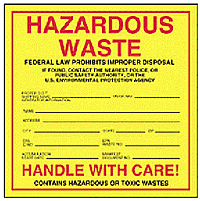Identification of Hazardous Waste

The first step in the management of hazardous waste is to determine whether a material is a "waste" and whether it is "hazardous". Subsequent steps are used to properly classify the waste and determine the action necessary for proper management of the waste.
Simply defined, a hazardous waste is a material with properties that make it dangerous or capable of harming humans or the environment if not properly managed. Making the determination of whether a waste is hazardous is complicated and requires an extensive understanding of such information as the waste constituents, how it was generated, the material's chemical and physical characteristics, an understanding of EPA and GA EPD regulations, and experience classifying waste products.
Materials are usually considered "waste" when the generator has determined that the material has no further use and will be discarded. Hazardous waste regulations apply to any material that will be discarded, or will likely to be discarded. (The latter point is important because materials that have no further use and will eventually be discarded may be considered hazardous waste by regulatory agencies even though there are no current plans to discard the material. Therefore, it is imperative that the department of EH&S or the Hazardous Waste Coordinator be consulted if materials will be stored for long periods without use or if the use of a material is not anticipated for extended periods.)
Waste materials can be solid, liquid, semi-solid or compressed gas. All such materials must be evaluated to determine if the hazardous waste regulations apply.
